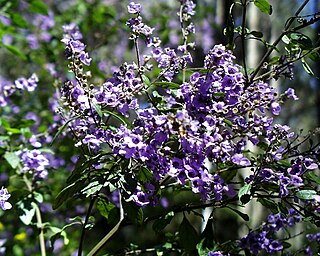
Prostanthera melissifolia, commonly known as balm mint bush, is a species of flowering plant in the family Lamiaceae and is endemic to south-eastern Australia. It is an erect shrub with hairy branches, egg-shaped leaves with fine teeth on the edges and mauve to purple or pink flowers on the ends of branchlets.

Prostanthera eurybioides, commonly known as Monarto mintbush, is a species of flowering plant in the family Lamiaceae and is endemic to the south-east of South Australia. It is a low, spreading shrub with densely hairy branches, thick, elliptic to egg-shaped leaves clustered on short shoots, and violet to mid-purple flowers that are white with orange and dark purple dots inside the petal tube.
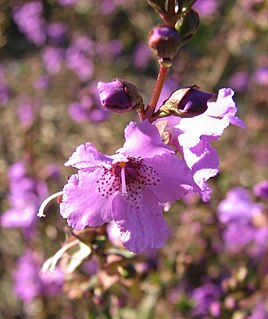
Prostanthera galbraithiae, commonly known as Wellington mint-bush, is a species of flowering plant in the family Lamiaceae and is endemic to Victoria in Australia. It is an erect or spreading shrub with densely hairy branches that are more or less square in cross-section, narrow egg-shaped or oblong leaves with the edges rolled under, and deep mauve to purple flowers with maroon dots inside the petal tube.

Prostanthera magnifica, commonly known as magnificent prostanthera, is a species of flowering plant in the family Lamiaceae and is endemic to Western Australia. It is a slender to spreading, erect shrub that has hairy stems, elliptical to narrow egg-shaped leaves and pale mauve or pale blue to pink flowers with prominent dark mauve to purple sepals.

Prostanthera stenophylla is a species of flowering plant in the family Lamiaceae and is endemic to Wollemi National Park in New South Wales. It is an erect, slender, aromatic shrub with hairy, oblong leaves and small groups of pale bluish mauve to violet flowers.
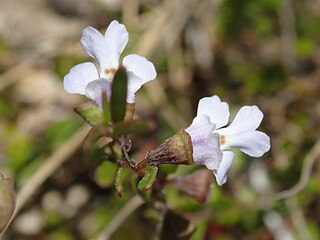
Prostanthera junonis, commonly known as Somersby mintbush, is a species of flowering plant in the family Lamiaceae and is endemic to the Central Coast of New South Wales. It is a low, straggling shrub with hairy, egg-shaped leaves and purple to mauve flowers.

Prostanthera althoferi is a species of flowering plant in the family Lamiaceae and is endemic to inland areas of Australia. It is an erect shrub with its stems and leaves densely covered with silvery, greyish-green hairs, and has narrow egg-shaped leaves and white to cream-coloured flowers with mauve or purple striations inside.

Prostanthera baxteri is a species of flowering plant in the family Lamiaceae and is endemic to the south-east of Western Australia. It is an erect shrub with narrow egg-shaped to linear leaves and white flowers with a tinge of blue to pale mauve.

Prostanthera canaliculata is a species of flowering plant in the family Lamiaceae and is endemic to the south-west of Western Australia. It is a small, erect shrub with hairy branchlets, narrow egg-shaped to narrow elliptical leaves and pale blue or pale violet to white flowers with no markings.
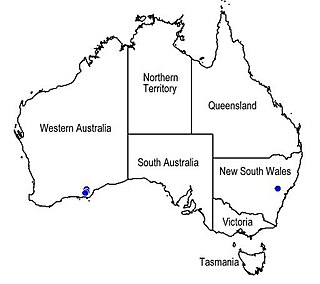
Prostanthera carrickiana, commonly known as Carrick's mintbush, is a species of flowering plant in the family Lamiaceae and is endemic to a restricted area in the south-west of Western Australia. It is an erect shrub with hairy branchlets, elliptical leaves pinkish-red flowers.
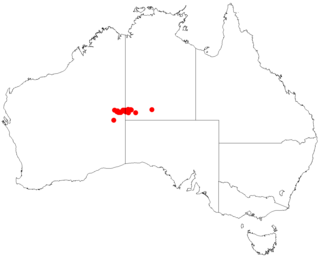
Prostanthera centralis is a species of flowering plant in the family Lamiaceae and is endemic to an area near the border between the Northern Territory and Western Australia. It is an erect shrub with hairy branchlets, hairy egg-shaped to elliptical leaves and mauve to blue flowers.

Prostanthera eckersleyana, commonly known as crinkly mintbush, is a species of flowering plant in the family Lamiaceae and is endemic to the south-west of Western Australia. It is an erect or spreading shrub with sticky, hairy branchlets, egg-shaped to elliptical leaves and blue, mauve to purple or violet flowers with maroon spots inside the petal tube.

Prostanthera ferricola is a species of flowering plant in the family Lamiaceae and is endemic to central Western Australia. It is an erect, openly branched shrub with aromatic, egg-shaped leaves and mauve-purple flowers arranged in four to twelve leaf axils near the end of branchlets.

Prostanthera incurvata is a species of flowering plant in the family Lamiaceae and is endemic to the inland of Western Australia. It is a small, erect shrub with hairy branches, narrow oblong to narrow egg-shaped leaves with the narrower end towards the base, and pink to red, sometimes yellow flowers.
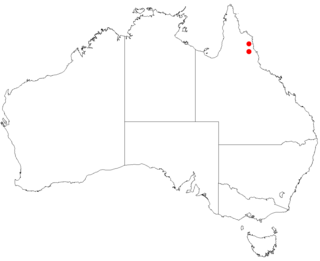
Prostanthera mulliganensis, commonly known as Mount Mulligan prostanthera, is a species of flowering plant that is endemic to Mount Mulligan in Queensland. It is a small shrub with hairy branchlets, oblong to egg-shaped leaves and mauve flowers with purple to dark mauve markings.

Prostanthera oleoides is a species of flowering plant that is endemic to central Queensland. It is an open, erect shrub with four-sided branchlets, narrow elliptic, oblong or egg-shaped leaves with the narrower end towards the base, and mauve flowers with purple to dark mauve markings.

Prostanthera patens is a species of flowering plant in the family Lamiaceae and is endemic to Western Australia. It is a small shrub with stiff, spine-like, hairy branches, egg-shaped to broadly elliptic, hairy leaves and red and orange to pale red flowers.

Prostanthera petrophila is a species of flowering plant in the family Lamiaceae and is endemic to Western Australia. It is a spreading shrub with densely hairy branches, narrow egg-shaped leaves with the narrower end towards the base and white flowers with violet striations in the petal tube.

Prostanthera scutata is a species of flowering plant in the family Lamiaceae and is endemic to Western Australia. It is a small, erect, compact shrub with densely hairy branches, elliptic to narrow elliptic leaves and pale blue or faintly violet flowers.

Prostanthera sericea, commonly known as silky mintbush or walyuwalyu, is a species of flowering plant in the family Lamiaceae and is endemic to inland Australia. It is an erect shrub with hairy branches, cylindrical leaves and white flowers with mauve or purple streaks.





















